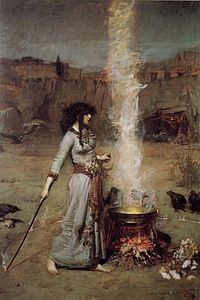
In Act IV – Scene I of Macbeth, Shakespeare’s three “weird sisters” prepare a “hell-broth” to produce a series of apparitions for Macbeth, that set in motion a chain of deadly events. Written only six years before the Lancashire Witch Trials, this script provides a good insight into magical beliefs of that time.
“Round about the cauldron go;
In the poison’d entrails throw.
Toad, that under cold stone
Days and nights hast thirty one
Swelter’d venom sleeping got,
Boil thou first i’ the charmed pot.
Double, double toil and trouble;
Fire burn and cauldron bubble.
Fillet of a fenny snake,
In the cauldron boil and bake;
Eye of newt, and toe of frog,
Wool of bat, and tongue of dog,
Adder’s fork, and blind-worm’s sting,
Lizard’s leg, and howlet’s wing,
For a charm of powerful trouble,
Like a hell-broth boil and bubble.
Double, double toil and trouble;
Fire burn and cauldron bubble.
Scale of dragon, tooth of wolf,
Witches’ mummy, maw and gulf
Of the ravin’d salt-sea shark,
Root of hemlock digg’d i’ the dark,
Liver of blaspheming Jew,
Gall of goat, and slips of yew
Sliver’d in the moon’s eclipse,
Nose of Turk, and Tartar’s lips,
Finger of birth-strangled babe
Ditch-deliver’d by a drab,
Make the gruel thick and slab:
Add thereto a tiger’s chaudron,
For the ingredients of our cauldron.
Double, double toil and trouble;
Fire burn and cauldron bubble.
Cool it with a baboon’s blood,
Then the charm is firm and good.”
Seeing this dramatic scene live on stage, the Jacobean audience would believe the witches had brewed some diabolical charm. They would be terrified, fascinated, mesmerized, and revolted by the disgusting ingredients – exactly as Shakespeare intended. But let’s take a closer look at his recipe.
The bard was not only a master playwright, he was also a shrewd psychologist who understood the minds of the masses who flocked to The Globe Theatre in London. Therefore it isn’t surprising that one of the first things thrown in the pot is the fenny snake, a nod to the snake who tempted Eve in the Garden of Eden. The Catholic Church claimed all women were necessarily evil because of Eve’s transgression and that’s why the majority of witches were female. The next three ingredients – eye of newt, toe of frog, and wool of bat – get added to the first item swelter’d toad venom – highlighting four nocturnal creatures that are often associated with witches and their familiar spirits. The liver of blaspheming Jew endorses the common anti-Semitic beliefs of that era, alongside the racial prejudices held against the Turk and Tartar. And Shakespeare further played into the beliefs of his class-conscious, biased audience by having a good man like Macbeth brought down by his scheming wife and a band of wicked hags.
A country audience, however, may have interpreted Macbeth’s cauldron quite differently from the royal courtiers and city dwellers. Many of these exotic ingredients are actually poetic variants on the common names for herbs. Fenny snake = chickweed; Eye of newt=mustard seed; Toe of frog = frog’s foot or bulbous buttercup; Wool of bat = bog moss; Tongue of dog = hound’s tongue; Adder’s tongue = adder’s tongue fern; Lizard’s leg = ivy; Howlet’s wing = henbane; Scale of dragon = dragonwort; Tooth of Wolf = wolf’s bane; Hemlock root = hemlock; Liver of Jew = Jew’s myrtle or box holly; Gall of goat = St. John’s Wort or honeysuckle; Slips of Yew = yew tree bark; Nose of Turk = Turk’s cap; Tartar’s lips = ginseng or tartar root; Tiger’s chaudron = lady’s mantle; and the Finger of birth-strangled babe= foxglove, also known as “bloody fingers”. The remaining items – toad venom, powdered mummy, shark, and baboon’s blood – were all widely thought to have medicinal properties.
Why did Shakespeare choose these fierce-sounding ingredients? Joyce Froome (Wicked Enchantments) argues that, for the wise women of Pendle, these herbs would be part of their everyday folk magic. Catt Foy (Witches & Pagans) suggests that maybe “Shakespeare knew a little more about herbcraft than he was letting on,” and Nigel Beale (Literary Tourists Blog) believes he chose names “designed to gross out the masses, to stop them from practicing magic.”
But William Shakespeare was also a poet. He knew the magic of words and rhythmical power of his hypnotic witch chant. It didn’t matter that these characters may have been throwing armfuls of common hedgerow roots and leaves into a boiling cook pot. What mattered was the awful-sounding names that conjured up terrifying images in the minds of his audience – and at this he was an unsurpassed wizard!
________
Kit is trying to raise money for the charity “Stepping Stones”, which continues to defend and uphold the rights of accused “Witch” children in the Niger Delta. You can find more information on facebook.com/kitperriman
Follow Kit’s blog at https://kitperriman.wordpress.com/
2 thoughts on “Shakespeare’s Recipe For Disaster, Guest Post by Kit Perriman”